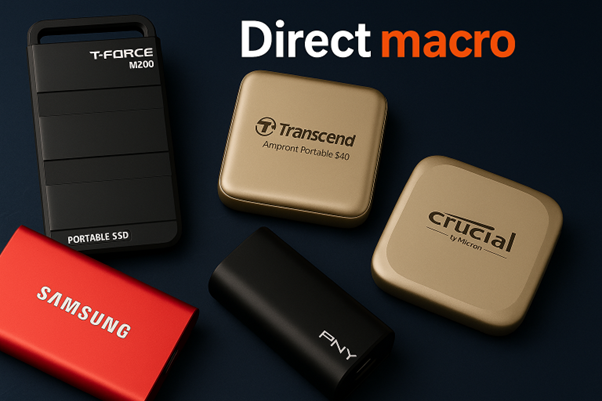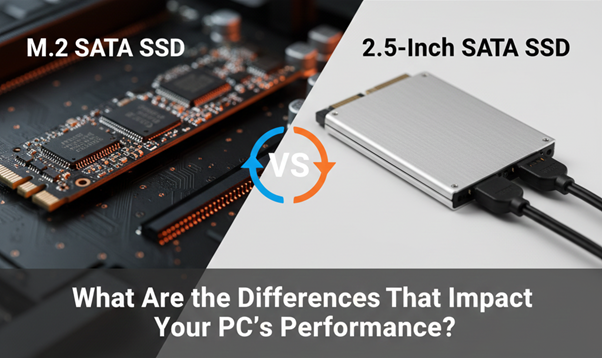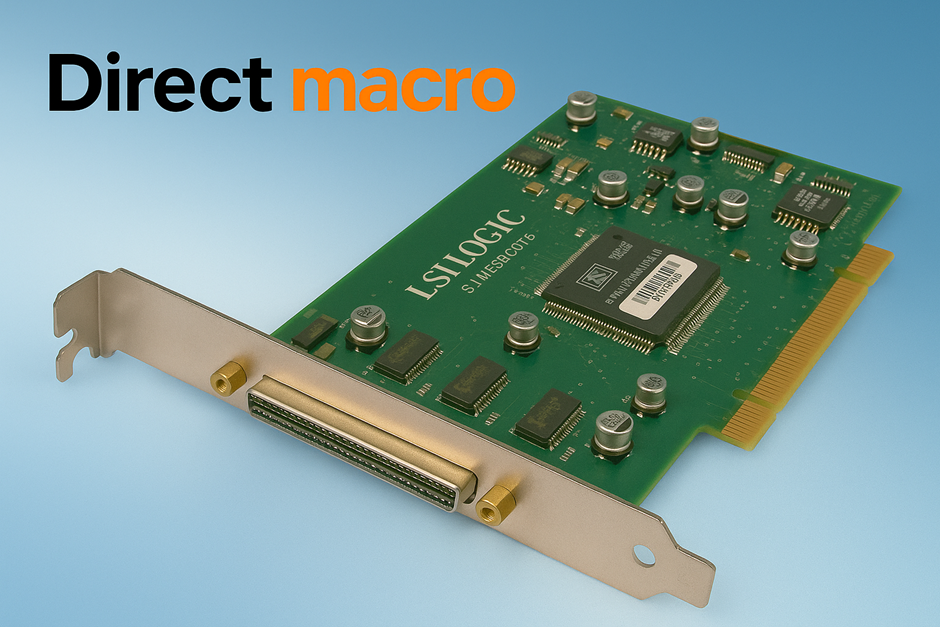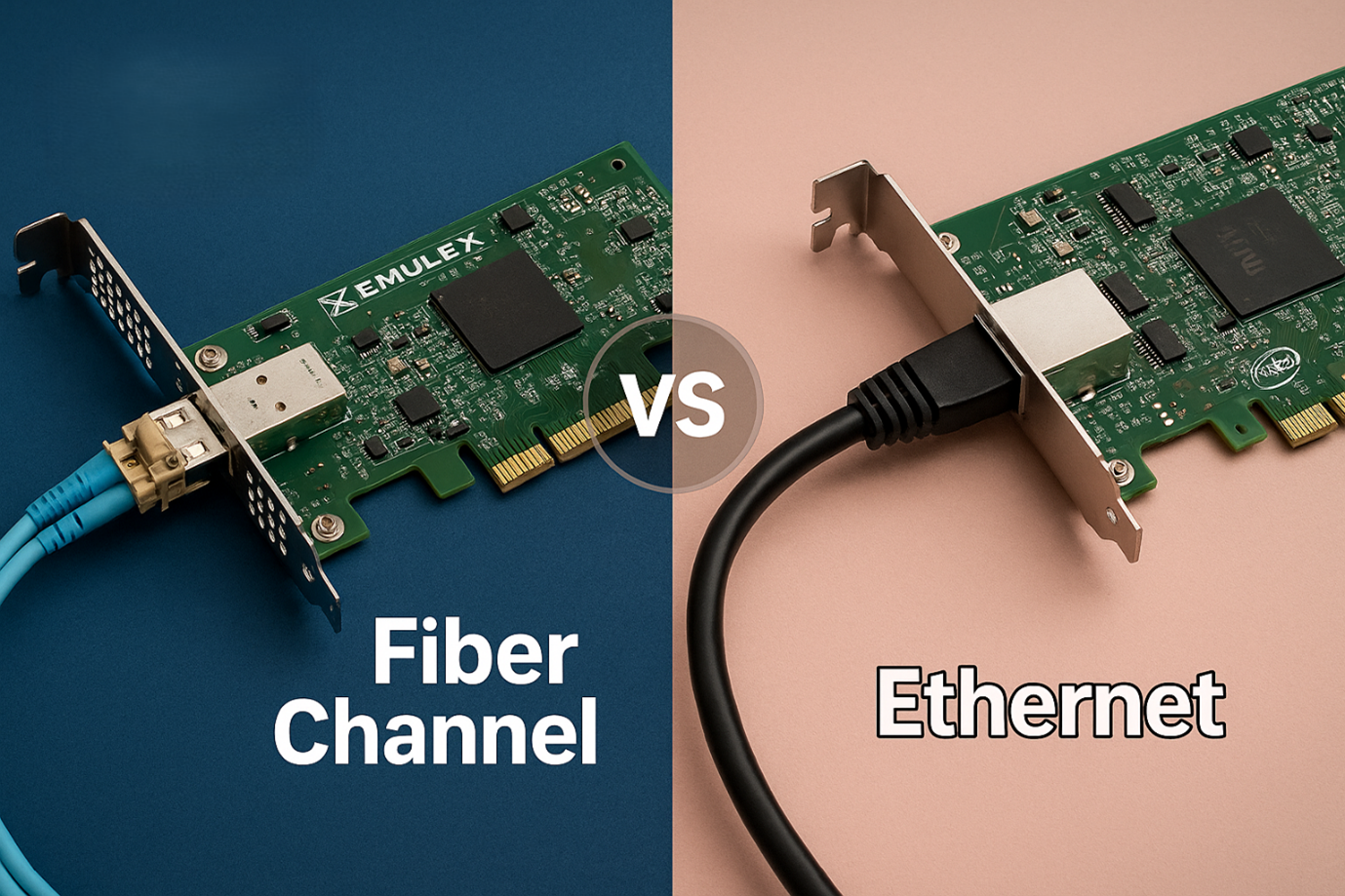External SSD vs. External Hard Drive: Which is Better?
In the modern world, external storage devices have become an indispensable tool for individuals seeking additional storage, file backups, and the transfer of large files. However, it is not easy to decide between an External SSD vs an External Hard Drive. Both type of technologies offers unique advantages and disadvantages, and often, the better option is entirely your choice based on your specific requirements, budget and use case.
In this comprehensive guide, we analyse deep into the key differences, performance features, and real-world applications of these two in-demand storage devices to help you determine which one is best suited to your needs.
External SSD vs External Hard Drive: The Fundamental Difference
The fundamental difference between an external SSD vs an external hard drive based on both specifications.
A hard disk Drive (HDD) is an older storage technology that utilizes spinning disks and read/write heads to access information Imagine a miniature record player inside a sealed enclosure. Its mechanical nature defines its performance and physical features, and also dictates how it can be used.
On the other hand, A solid state drive SSD uses flash memory (NAND) to store information. An SSD does not have any moving parts, and retrieval is electronic on a huge scale when compared to USB flash drives. This difference is the root of the performance, durability and cost differences.
External SSD vs External HDD Speed Comparison
The external SSD is a clear winner when we talk about raw speed. This is arguably the most significant differentiator and a critical factor for many users.
| Feature | External SSD | External HDD |
| Read/Write Speed | 400–2000 MB/s | 80–160 MB/s |
| Boot Time (if OS used) | ~10 seconds | ~30–45 seconds |
| File Transfer (10 GB) | ~10–20 seconds | ~2–4 minutes |
External SSD vs External HDD speed comparison showcases a huge speed difference. Most External HDDs are connected via USB 3.0 and 3.1, and their sequential read and write speeds range from 80 to 160 MB/s (megabytes per second). Some desktop HDDs with high RPMs may be able to achieve a bit more, but the speed of their spinning platters will ultimately limit their performance.
External SSDs do take advantage of USB technologies like USB 3.2 Gen 2, USB 3.2 Gen 2×2, and even Thunderbolt. Thus, they provide access to faster speeds.
- Tier 1 or Entry Level External SSDs, which use USB 3.2 Gen 1 or USB 3.0 equivalent, can achieve speeds of 400-550 MB/s.
- Tier 2 or Mid-range external SSDs also utilize USB 3.2 Gen 2 and are expected to provide speeds of 800-1,050 MB/s.
- Tier 3 or High-Performance External SSDs, using USB 3.2 Gen 2×2 or Thunderbolt 3/4, can reach speeds of 2,000 MB/s to 4,000 MB/s or more with suitable ports.
Due to the immense speed difference between SSDs and HDDs, an external HDD will take over 10 minutes to transfer a single 100GB file, while an external high-speed SSD will complete the transfer in under a minute. For tasks that include regular read and write operations of large files, the transformative speed advantage that SSDs provide is unquestionable.
Is External SSD Better Than External HDD?
The simple answer to the question “Is an external SSD better than an external HDD?” is: SSDs are better only in some situations, and it also depends on your requirements and priorities.
An external SSD is the clear winner if your main concerns are speed, durability, and portability. Its faster data transfer rates, resistance to physical shock, and compact size are beneficial for active use cases.
Still, external HDDs are better if your goal is cost efficiency and maximum storage capacity for archived data. HDDs offer a much lower cost per gigabyte, making them perfect for storing large libraries of photos, videos, or documents where immediate access speed is not a priority.
That is why choosing between SSD and HDD is entirely based on your requirements. Knowing both the advantages and disadvantages of a solid-state drive vs a hard disk drive will help you in your selection.
Advantages and Disadvantages of External SSDs
External SSDs have gained popularity very quickly due to their unique performance characteristics. Here are the advantages and Disadvantages of external SSDs:
Advantages of External SSDs
- Blazing Speed: External SSDs have faster read and write speeds when compared to other drives which aids in quickly loading applications and transferring files.
- Exceptional Durability: SSDs are shock proof because they don’t have moving parts. This makes external SSDs ideal for users who are constantly travel and who need a durable storage drive that can bear accidental knocks.
- Portability and Compact Size: SSDs are smaller and lighter than external HDDs. Their size being equivalent to a pack of gum or a credit card makes them easy to throw in a pocket or bag.
- Silent Operation: Lack of mechanical parts allows SSDs to operate quietly, making them a pleasant change from the whirring and clicking noises of HDDs.
- Lower Power Consumption: SSDs utilise less power, which is beneficial for laptop users, leads to an extended battery lifespan alongside generate less heat.
- Faster Boot/Load Times: An SSD will provide noticeably faster experience if you are running an operating system or an application directly from the external drive.
Disadvantages of External SSDs
- Higher Cost per Gigabyte: It remains the primary drawback for both external SSDs (solid state drives) and external HDDs (hard disk drives). An external SSD costs much more than an external HDD for the same storage. At the same time, the gap is slowly reducing with time, especially for larger storage devices with higher capacities.
- Lower Maximum Capacity: SSD prices are shooting up, and the demand is increasing as well. However, the highest capacity external SSD still lags behind external HDDs. As of 2025, external HDDs are offering capacities of 10TB, 16TB, or even 20TB+ configuration, whereas External SSDs still cap out around 8TB, with higher capacities being prohibitively expensive.
- Performance Dependent on Interface: To utilize the highest speeds, external SSDs need a high-speed port (USB 3.2 Gen 2×2, Thunderbolt) on your computer. An older USB 3.0 port will use a Gen 2×2 SSD, which results in restricted performance.
Categories of External Storage Devices
1. External SSD for Gaming
For gamers, using an external SSD for gaming has its perks. Open-world games, like many other modern games, require massive file sizes and significant assets streaming. With an external SSD, storing and launching games significantly reduces load time, in-game stuttering, and texture pop-in. While an internal SSD for better performance is still the best option for your primary gaming drive, an external SSD is perfect for expanding your game library without losing performance.
2. External SSD vs External HDD for Video Editing
The decision between an external SSD vs an external HDD for video editing is critical for content creators, especially those working with 4K and 8K video. Video editing is a highly scrutinized workflow that necessitates massive amounts of storage space for the original, rendered, and exported files. An external SSD drastically speeds up the process of footage import, timeline scrubs, interaction with non-linear editing systems, and final project rendering. The faster read and write speeds minimize bottlenecks, which allow a smoother and more efficient editing experience. On the other hand, HDDs can store finished projects, and doing editing directly from them would be a frustratingly slow endeavor.
3. Portable External SSD vs External HDD
The aspect of portability is a big favor for SSDs. A comparison of a portable external SSD vs an external HDD shows how easy to use an SSDs. Because they are small and lightweighted and also, they are easy to carry around. You do not have to worry about accidentally bumping an external SSD and possibly corrupting data or damaging the drive. On the other hand, HDDs are sensitive to movement during operations. This makes them great for professionals who travel, photographers who work on different location, or students who are moving between classes.
4. External SSD vs External HDD Power Consumption
When it comes to external SSD vs external HDD power consumption, SSDs are usually better than HDDs. They are more power-efficient. An external SSD might use around 2 to 3 watts during active use, and when not in use, it might consume less. On the other hand, an external HDD can use 6 to 7 watts or more while active hours with its spinning platters and moving heads. For laptops and other devices that run on batteries, this difference can make the battery life noticeably last longer. This might not be a big deal for a desktop setup, but it’s a plus for mobile users and bigger deployments where saving energy over time is essential.
Advantages and Disadvantages of External HDDs
Even though SSDs are becoming more popular, external HDDs still have a significant market share because they offer unique advantages and disadvantages for specific use cases.
Advantages of External HDDs
- Significantly Lower Cost per Gigabyte: It is the best HDD by a long shot. External hard drives are the best choice for storing large amounts of data due to their ample storage capacity.
- Much Higher Maximum Capacity: External HDDs are available in wide range of capacities from a few terabytes to 20TB or more in a single-drive enclosure. This makes them perfect for huge archives or large media libraries.
- Time-Tested and Reliable for Archival: HDDs have been around for decades and are a proven, reliable way to store data for a long time, especially data that is not accessed often.
Disadvantages of External HDDs
- Slower Performance: Because HDDs are mechanical, they are naturally much slower than SSDs. It means they takes longer time to transfer files and slower access them.
- Fragility and Sensitivity to Shock: HDDs have moving parts, so they can be damaged by drops or impacts, especially when they are in use. A sudden jolt can cause the read/write heads to crash into the platters, resulting in data loss.
- Bulkier and Heavier: HDDs are bigger and heavier because of their internal parts, which makes them less convenient for traveling often than SSDs.
- Audible Noise: The spinning platters and moving heads make audible noise such as (whirring, clicking), which can be noticeable especially in quiet places.
- Higher Power Consumption: As we mentioned above HDDs use more power than SSDs, which can impact laptop battery life.
Best External Hard Drive for Backup
the best external hard drive for backup remains an excellent choice for comprehensive data redundancy. Their low cost per gigabyte allows users to acquire vast storage capacities for relatively little money, making it practical to create full system backups, store entire media collections, or archive years of documents. Many external HDDs come with bundled backup software. It simplifying the process. While slower, for a set-it-and-forget-it backup solution, their capacity and affordability make them ideal.
External SSD vs External HDD Reliability
When looking into the external SSDs vs external HDDs reliability, each has its advantages and disadvantages. Let discuss:
- Physical Durability: SSDs are shockproof far better than external HDDs. An external HDD would break after a drop, whereas an SSD would be unaffected. It makes SSDs the go-to choice for portable devices and for fieldwork.
- Lifespan (Write Cycles): An SSD has a number of write cycles it can handle (how many times data can be written to a specific cell) before its performance starts to decline or the unit completes fails. However, Modern SSDs offer a lifespan for many years with a burn rate exceeding its practical value during consumption. Cells are guaranteed to be written to with advanced algorithms that over-provision and wear-level.
- Mechanical Failure: An external HDD is prone to having a motor, head, or bearing wear which leads to sudden drive failure. An external SSD will outperform an external HDD as they do not contain mechanical points of failure.
- Data Degradation: An external SSD and an external HDD both can experience data degradation after not having power for a long time or store data without power, though this is not a concern for frequently used external drives.
For enterprise-grade external storage solutions no matter it is an SSD or HDD, the best storage controller for data protection plays an importance role. These external grade storage solutions are fitted with advanced features like ECC (Error Correction Code), TRIM support, and advanced wear-leveling algorithms for SSDs, or RAID capabilities for HDDs to guarantee data safety and ensure the drive best protection.
Choosing Your Best External SSD 2025
The external SSD market is highly competitive as of 2025, with constant updates to speed and storage capabilities. When looking to buy an external SSD online, consider the following points to find the best external SSD 2025 and beyond:
- Interface Compatibility: Check your system USB ports. USB 3.2 Gen 2 (10Gbps) is widespread and offer excellent speed. If you have USB 3.2 Gen 2×2 (20Gbps) or Thunderbolt 3/4 ports, you can get even better speeds, but make sure that they provided the SSD supports as well.
- Capacity: Assess how much storage you need. External SSDs with 4TB and 8TB are more popular among users, though they are more expensive than 1TB and 2TB external SSDs. You can choose your desired capacity as per your budget or system requirements.
- Budget: External SSDs are more expensive. So, when you are looking for new purchase then define your budget, prioritize speed, storage, SSD build quality, and ruggedness.
- Brand Reputation: Stick to reputable brands of external SSD that have proven to be reliable storage solutions and sell high-quality devices, such as Samsung, Crucial, SanDisk, Western Digital, and Kingston. Or you can also visit the Direct macro website to make your next purchase.
- Features: Do you require the SSD to have hardware encryption, specific ruggedness ratings (IP rated for water and dust resistance), or backup software bundled? Then checkout our top 5 best external SSDs we listed below.
Top 5 Best External SSD 2025 – Direct Micro
Are you looking for the best external SSD 2025? Checkout these five standout options from Direct Macro combine speed, durability and compatibility which are ideal for content creators, gamers and professionals:
1. Transcend ESD420 Portable SSD
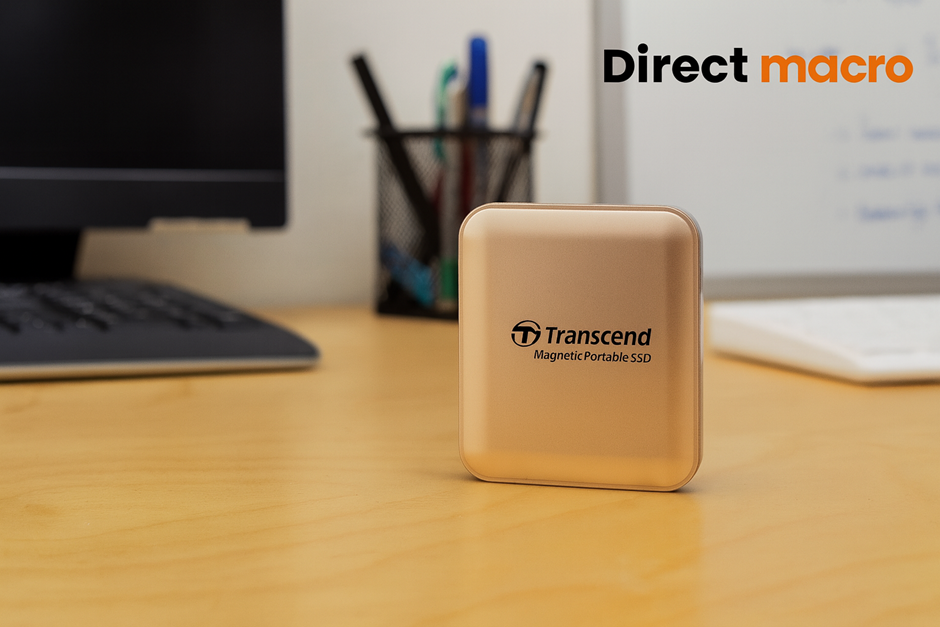
The most durable portable SSD in 2025 is the Transcend ESD420 Portable SSD. Check out the specifications when you buy these fantastic products, and the reasons to avoid making the wrong decision.
Specifications
- Capacities: 1TB, 2TB, 4TB
- Transfer Protocol: USB 3.2 Gen 2×2 (20 Gbps)
- Transfer Speeds: Up to 2,000 MB/s
- Design: Magnetic body, compatible with MagSafe
- Durability: MIL-STD-810G drop resistance
- Security: AES 256-bit hardware encryption
- Weight: 48g
- Warranty: Limited (Varies by region)
Reasons To Buy
- Ultra-durable and drop-resistant
- Great for iPhone and iPad users with MagSafe compatibility
- Excellent performance for the size
- Hardware encryption adds data protection
Reasons To Avoid
- Slightly premium price for 4TB variant
- Limited color/design options
2. PNY Elite Portable SSD (Up to 480GB)
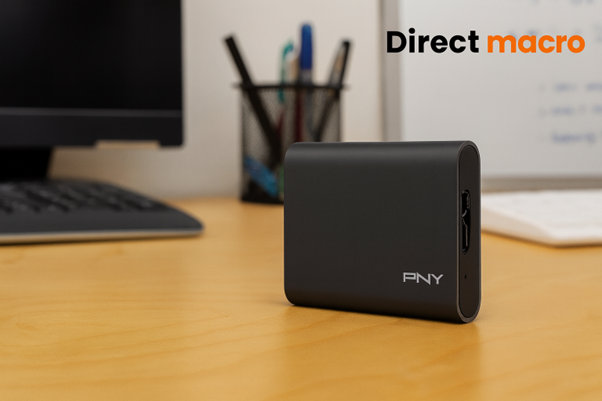
If you are looking for the best budget SSD for casual use or daily projects, the PNY Elite Portable SSD is the best option. This SSD offers up to 480GB capacity, which is a great deal. Let’s discuss its specifications and reasons to buy and avoid.
Specifications
- Capacity: Up to 480GB
- Transfer Protocol: USB 3.0
- Read Speeds: Up to 430 MB/s
- Write Speeds: Up to 400 MB/s
- Design: Ultra-compact aluminium housing
- Software: Includes Acronis Backup
- Compatibility: Windows and Mac
- Warranty: 3 Years
Reasons To Buy
- Affordable and reliable for basic storage needs
- Lightweight and portable aluminium build
- Plug-and-play functionality
- Energy-efficient and silent operation
Reasons To Avoid
- Lower capacity compared to modern competitors
- Slower speed than Gen 2×2 SSDs
3. Samsung T7 Portable SSD
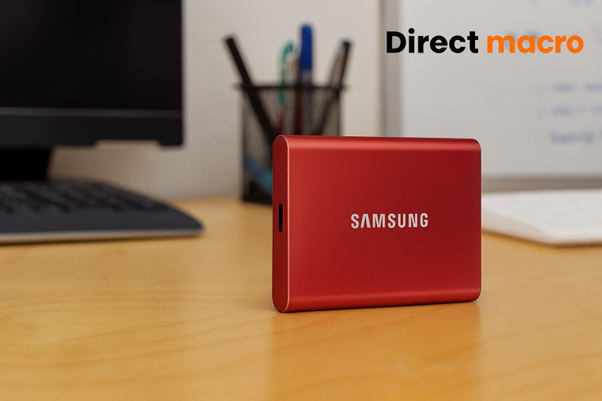
If you are looking for the best portable SSD, then the top choice for speed and portability is the Samsung T7 SSD. This SSD offers up to 1,050 MB/s read and 1,000 MB/s write speeds, making it an excellent option for gamers, content creators and professionals. Let’s dive in to find out the reasons to make your next purchase by understanding its specifications.
Specifications
- Capacities: 500GB, 1TB, 2TB
- Transfer Protocol: USB 3.2 Gen 2
- Speeds: Up to 1,050 MB/s Read, 1,000 MB/s Write
- Security: Hardware AES 256-bit encryption
- Durability: Shock-resistant aluminum case
- Compatibility: Windows, macOS, Android, consoles
- Warranty: 3 Years
Reasons To Buy
- Fast and consistent real-world performance
- Compact and stylish aluminum casing
- Strong encryption and data protection features
- Backed by Direct Macro’s trusted catalog
Reasons To Avoid
- Lacks Thunderbolt support
- No IP-rated water/dust resistance
4. Crucial X10 / X9 Pro SSD
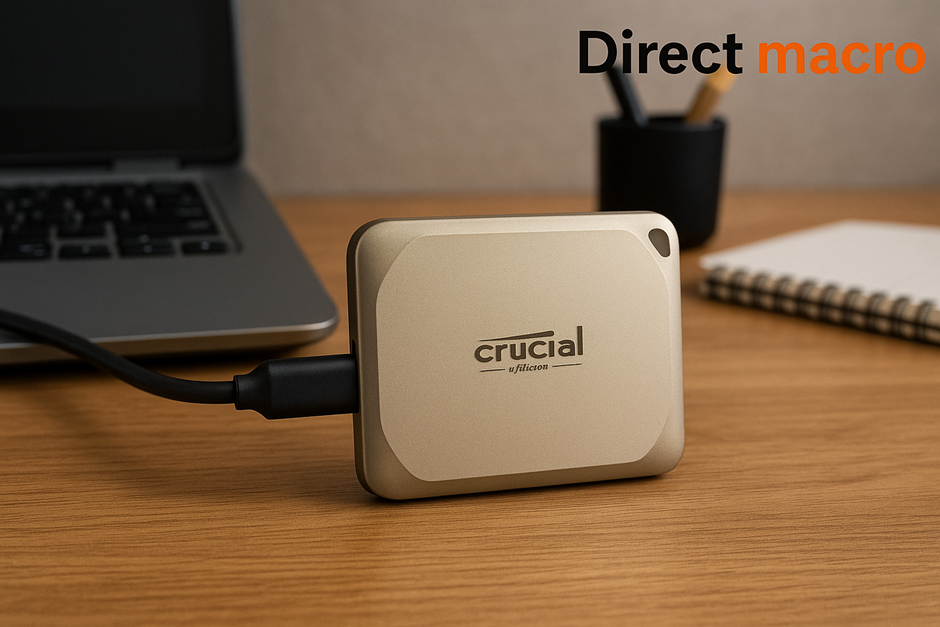
If you are a gaming enthusiast or video editor, then crucial X10 SSD and Crucial X9 Pro SSD are the best external SSDs for gaming and editing. This purchase will never disappoint you, as it is compatible with PS5, Xbox, PC, and Mac and backed by a 3-year warranty.
Specifications
- Capacities: 1TB, 2TB, 4TB
- Interface: USB-C (USB 3.2 Gen 2 or 2×2)
- Speeds: Up to 2,100 MB/s (X10 Pro)
- Design: Ultra-portable, rugged construction
- Compatibility: PS5, Xbox, PC, Mac
- Warranty: 5 Years
Reasons To Buy
- High-speed data transfers for 4K/8K editing
- Durable and travel-friendly form factor
- Excellent compatibility with consoles and laptops
- Available through Direct Macro with latest models
Reasons To Avoid
- Slight thermal throttling under sustained loads
- X9 model slightly slower than X10
5. Team Group T-Force M200 SSD
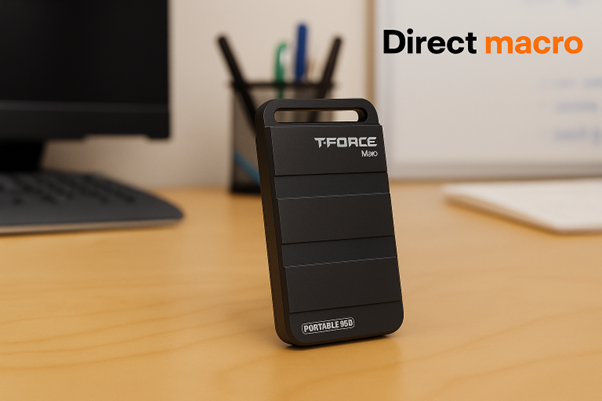
If you are a gamer seeking the best budget 20GBPS SSD with massive storage, consider the Team Group T-Force M200 SSD’s specifications. It is compatible with both PCs and gaming consoles, offering high capacity.
Specifications
- Capacities: 1TB, 2TB, 4TB, 8TB
- Interface: USB 3.2 Gen 2×2 (20Gbps)
- Speeds: Up to 2,000 MB/s
- Build: Rugged heatsink design for thermal management
- Compatibility: PC, gaming consoles
- Warranty: Manufacturer-limited (check Direct Macro listing)
Reasons To Buy
- Blazing-fast 20Gbps performance
- One of the few 8TB external SSDs available
- Excellent thermal control under load
- Budget-friendly pricing for such capacity
Reasons To Avoid
- Larger and heavier than typical portable SSDs
- 8TB model can be hard to find in stock
Direct macro is the most trusted platform to buy your following product. Don’t miss the chance to get a significant discount on your next purchase. For support, call us at (855) 483-7810 or visit the Direct macro store for high-quality products details and bulk purchase.
Conclusion: The Future is Fast, But Capacity Still Matters
When deciding between an external SSD vs external hard drive, the choice ultimately depends on your needs. There is no clear answer for either option.
- Pick an External SSD if: For things like video editing, gaming, running demanding apps, or moving large files often, speed is the most important thing. You value portability and durability above all things, and your budget allows you to pay more per gigabyte then choose an external SSD.
- Pick an External Hard Drive if: You need a lot of affordable storage for system backups, archives purposes, or media libraries where access speed is not a big deal. You are willing to give up speed and toughness in exchange for more space and lower costs.
Many users even opt for a hybrid approach: an external SSD for active, performance-critical projects and an external HDD for long-term, cost-effective archival storage. External SSDs will keep getting faster and cheaper as technology improves, but the simple external hard drive will probably still be a strong option for bulk, budget-friendly storage for years to come.
Frequently Asked Questions
- Is external SSD better than HDD for gaming?
Yes, an external SSD is usually a lot better than an HDD for gaming. It makes games load faster, reduces texture pop-in, and stops stuttering in general, making for a smoother and more responsive gaming experience. Internal SSDs for better performance are the best choice for your primary gaming drive because they offer superior performance. However, an external SSD is a great way to add more games to your library without losing too much performance.
- Which is more durable: SSD or HDD?
SSDs are significantly more durable than HDDs. HDDs have fragile, moving mechanical parts (spinning platters, read/write heads) that are susceptible to damage from drops, impacts or vibrations, mainly when operating. SSDs, being solid-state devices with no moving parts, are far more resistant to physical shock, making them a more robust choice for portable use.
- Should I choose an external SSD or HDD?
You should choose an external SSD if your priorities are speed (for tasks like video editing, gaming, or quick file transfers), portability, and durability. You should choose an external HDD if your main priority is ample storage capacity at the lowest possible cost, primarily for backups or archiving large amounts of data that do not require frequent, high-speed access. Consider your budget and primary use case carefully before making any purchase.
Do you need advice on buying or selling hardware? Fill out the form and we will return.

Sales & Support
(855) 483-7810
We respond within 48 hours on all weekdays
Opening hours
Monday to thursday: 08.30-16.30
Friday: 08.30-15.30



